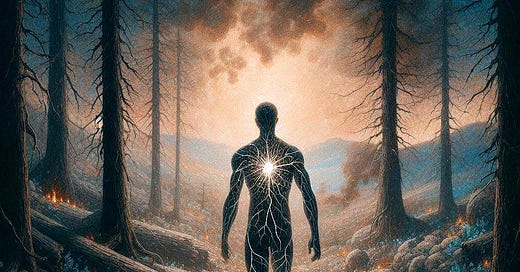Resilience as the Courage to Carry Our Wounds
The human heart holds a remarkable capacity: we are able to integrate what has broken us into what makes us whole.
This truth often goes unnoticed in a world that urges us to move on, get over it, or return to how things were before. But the most human thing about us is not our ability to bounce back—it’s our ability to carry what has marked us, to reshape our lives with those marks visible and intact. Real strength doesn’t come from pretending the fire never touched us. It comes from walking forward with the scent of smoke still clinging to us, knowing that we endured and are still becoming.
The healing journey asks something deeper than forgetting—it asks for a kind of love that embraces all that has happened, a tenderness that welcomes every version of ourselves that got us here. Some parts of us still carry grief, some still lash out in fear, some still wait for someone to say, “You’re safe now.” These parts don’t need to be erased or silenced. They need to be seen and held with mercy.
To grow is not to discard what hurt us. To grow is to make space for our most confused, shamed, and wounded parts to know they belong too. We don’t heal by force or by willpower. We heal when we feel safe enough, loved enough, steady enough to let go of the old armoring. That takes time. It takes patience. And it takes a vision of humanity that includes all our ragged edges.
We become whole not by going backward, but by saying yes to who we are today—shaped, not shattered.
There are moments when the idea of healing feels out of reach. Maybe it’s because we’ve circled back to the same pain too many times. Or because we’ve tried to grow but keep tripping over the same old fears. It’s easy to believe something’s wrong with us, or that we’ve failed in some silent, unforgivable way.
But this too is part of being human.
The healing path is rarely straight. It winds through old patterns, painful memories, and tender places we’d rather not revisit. And yet, this winding path is not a mistake. It’s a sacred rhythm. One where the ache of returning again and again teaches us to move with compassion, not condemnation.
Each time we circle back, we’re not starting over—we’re deepening. We’re learning to respond differently. We’re creating inner conditions where the most hurting parts of us can finally relax. When we stop treating those parts like enemies and begin to honor them as protectors or messengers, something changes. The space between harm and healing softens. A different kind of resilience takes root.
This is not about forcing transformation. It’s about creating enough mercy inside us to let what’s still afraid come into the light.
The implications are not just personal. A humanity capable of holding its wounds with reverence is a humanity capable of real change. This kind of inner mercy spills outward—into our relationships, our systems, our futures. When we stop demanding perfection and start honoring process, we find the strength to keep going—together.
Let your healing be as slow and strange as it needs to be. Let it be yours.
Deeper Reflection:
What part of you still needs to be told, “You’re safe now,” and how might you speak to it with mercy?
Heart of the Message:
Resilience is not about returning to a former state but about honoring the new form shaped by wounding, memory, and healing through merciful integration.
We are marked,
not ruined.
Changed,
not erased.
The fire did not spare us—
it shaped us.
We carry the memory,
not as burden,
but as proof:
we endured.
We circle back,
again and again,
not in failure,
but in fidelity
to what longs
to be seen,
to be known,
to be held
until it softens
into light.




